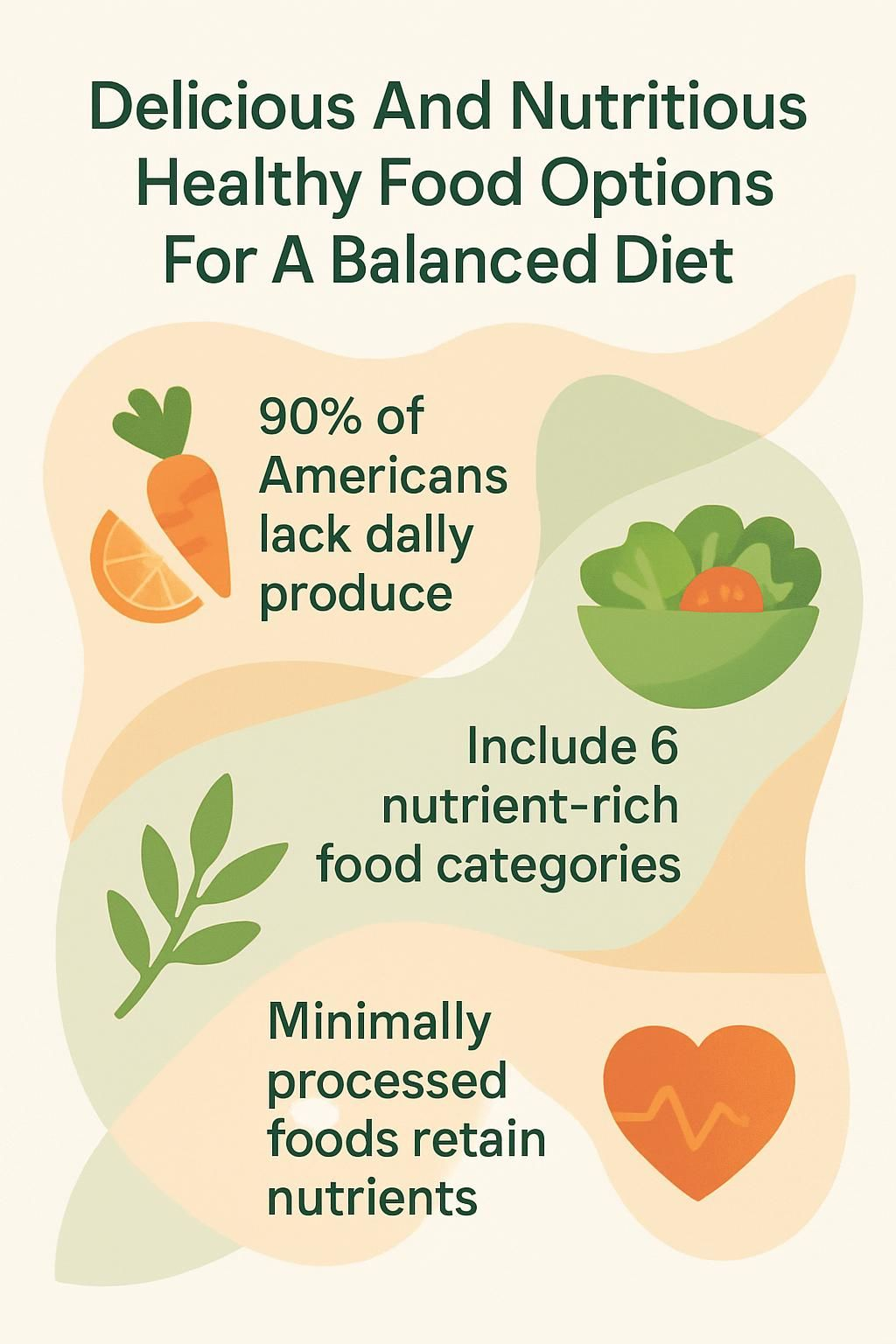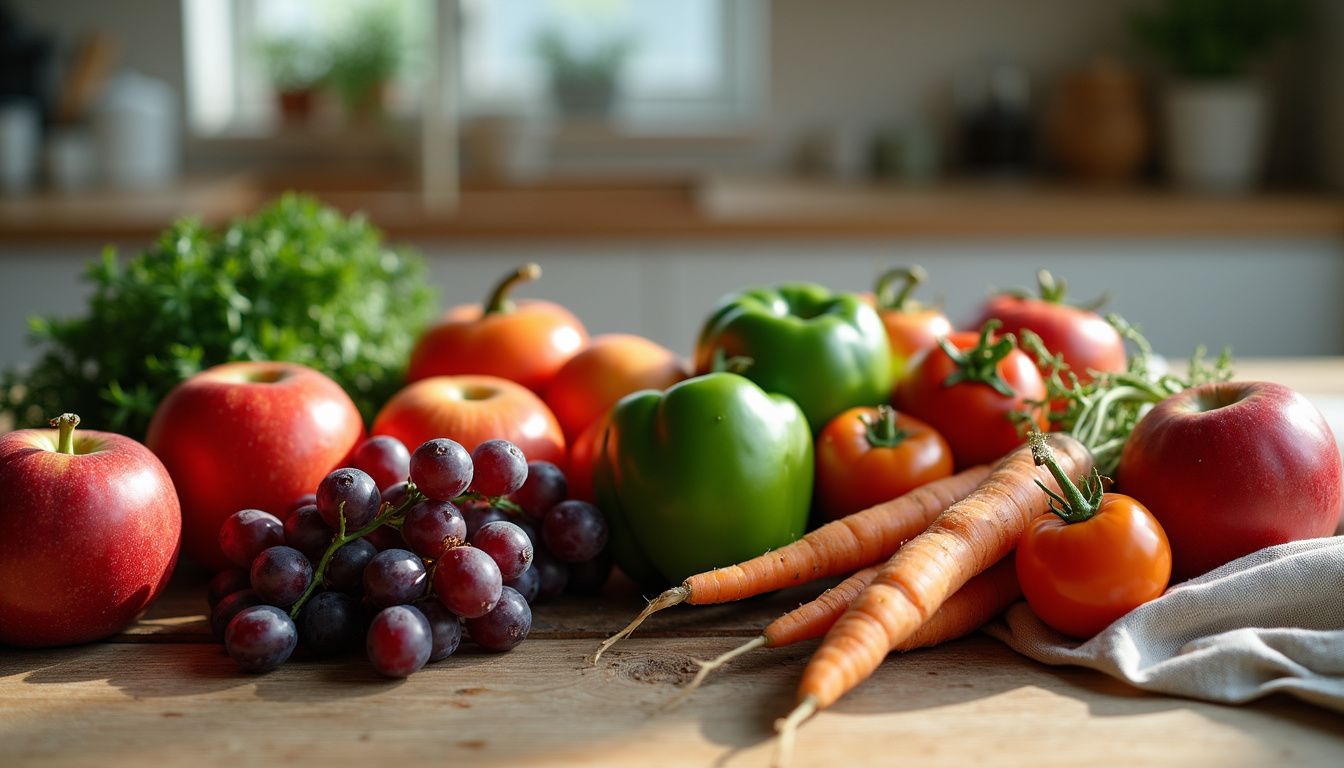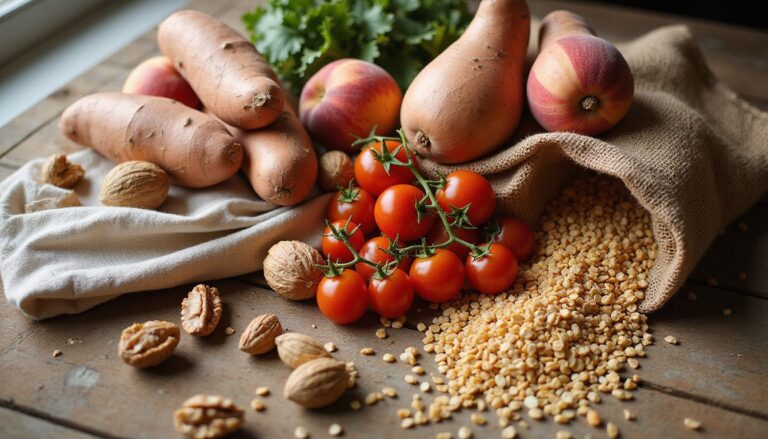Delicious And Nutritious Healthy Food Options For A Balanced Diet
Our Nutrition Assistant AI Suite will transform your body. You will lose fat, get toned, and build muscle. Gain confidence and optimal health.
Finding healthy foods that taste great and fit a balanced diet can feel hard. Healthy eating becomes easier with a simple plan and a few reliable choices. The CDC reports that nearly 90% of Americans fall short on fruits and vegetables each day, which raises health risks.
I use a straightforward approach. I pick foods that give key nutrients, then build meals around them. In this article, I share practical tips, quick swaps, and foods that make building healthy meals less stressful.
Each idea leans on current guidance and real data. Try a few this week and see which ones help you feel better and more energized.
Key Takeaways
- Nearly 90% of Americans do not eat enough fruits and vegetables daily, according to the CDC, which raises the risk for chronic conditions.
- A balanced diet includes whole grains, lean proteins, dairy or alternatives, fruits, vegetables, healthy fats like extra-virgin olive oil, and nuts, as outlined in the Dietary Guidelines for Americans (2020–2025).
- Choosing minimally processed foods preserves vitamins and minerals while lowering added sugar, sodium, saturated fat, and artificial preservatives.
- Key nutrients in healthy foods, such as fiber in apples, omega-3s in salmon and walnuts, calcium in dairy milk, and protein in lentils, are linked with lower cholesterol and better heart health.
- Variety across all food groups supports steady energy, long-term weight management, and fewer nutrient gaps.

What Defines a Healthy Food?

Healthy foods supply the nutrients your body needs to work well. I aim for a wide mix of whole grains, vegetables, fruits, proteins, and dairy or alternatives to build healthy eating patterns.
What nutrients should healthy foods provide?
Healthy foods should provide carbohydrates for energy, protein for muscles, and healthy fats for heart and brain function. They should also include vitamins, minerals, and dietary fiber. Whole grains give complex carbohydrates that digest more slowly, which steadies energy.
Lean meats and plant proteins repair tissues and support strength. Nuts and seeds offer unsaturated fats that support heart health. Fruits and vegetables deliver vitamins like vitamin C and vitamin A, and minerals such as potassium and magnesium, which help control blood pressure and immunity. Dairy or fortified alternatives add calcium for bones. Beans and other fiber-rich foods support digestion.
When I eat a range of these nutrient-rich foods, I meet my needs without too much added sugar or saturated fat.
A balanced diet means each meal delivers carbs, protein, fat, fiber, vitamins, and minerals in the right amounts.
Why is variety and balance important in a diet?
Variety helps cover your full range of nutrients. Each food group contributes something different. This mix supports heart health, bone strength, and lowers the risk for conditions like type 2 diabetes and cardiovascular disease.
Following MyPlate keeps portions sensible and highlights vegetables, fruits, whole grains, lean proteins like fish or poultry, and healthy oils such as olive oil. Research links eating a variety of produce with better cholesterol levels and healthier body weight. The Dietary Guidelines for Americans (2020–2025) also note that pairing calcium and vitamin D with protein helps maintain muscle as you age.
Rotating foods keeps meals interesting and reduces the chance of missing key nutrients.
How does minimal processing affect food healthiness?
Minimal processing helps foods keep their natural vitamins, minerals, and fiber. Fresh produce, nuts, and seeds are rich in nutrients with lower sodium and no trans fat. Whole grains like brown rice and oats keep more B vitamins than refined options like white bread or white rice.
I aim for salads and snacks that are low in added sugars and made without heavy preservatives. Plain yogurt often has a stronger nutrition profile than flavored varieties with extra sugar.
Fruits and Berries
Fruits and berries deliver vitamins, minerals, and fiber in a sweet, portable package. I add them to breakfast, snacks, and desserts for taste and steady energy.
What are the health benefits of apples?
A medium apple has about 95 calories, 4 grams of fiber, vitamin C, and potassium. Harvard Health Publications reports that apple fiber supports healthy cholesterol levels, aids digestion, and helps you feel full longer. Apples also contain flavonoids, which are plant compounds that may lower the risk of cardiovascular disease and some cancers.
I often pack sliced apples for quick snacks. The antioxidants in the peel fight inflammation. The saying an apple a day keeps the doctor away
still nudges me to include them often.
How do avocados contribute to a balanced diet?
Avocados bring mostly monounsaturated fats, which support heart health better than saturated fat. They also deliver potassium, even more per gram than bananas. A 100 gram serving offers about 485 milligrams of potassium.
One avocado provides close to 10 grams of fiber, plus folate, vitamin K, vitamin E, magnesium, and small amounts of iron and zinc. The blend of healthy fat and fiber helps me feel full longer. I swap avocado for butter on toast and add slices to salads for a simple upgrade.
Why are blueberries considered superfoods?
Blueberries supply antioxidants, fiber, and vitamin C. One cup gives about 24% of the daily value for vitamin C and provides manganese, which supports metabolism.
Studies link blueberries with lower blood pressure and less oxidation of LDL cholesterol. I add a cup to breakfast because they are low calorie, about 80 calories per cup, and come with big benefits. Research also connects regular blueberry intake with sharper memory and steadier blood sugar.
What nutrients do oranges provide?
Oranges are rich in vitamin C, fiber, potassium, and folate. A medium orange has about 70 milligrams of vitamin C, which supports immunity and helps you absorb iron from plant foods. Oranges also supply B vitamins like thiamin and small amounts of calcium.
They are fat free and have around 60 calories each. The antioxidants, including beta-carotene, support heart health. I grab an orange for a quick, energizing snack that fits my plan.
How do strawberries support overall health?
Strawberries deliver vitamin C, fiber, and antioxidants that protect cells from damage. One cup offers close to 150% of the daily value for vitamin C, which supports immunity and skin.
Research links strawberries with lower LDL cholesterol and less inflammation. They are low calorie and high in water, which helps with weight control. I keep a bowl in the fridge for a simple, sweet snack.
Vegetables
Vegetables provide vitamins, minerals, and fiber that support many body functions. I build most meals around a colorful mix to raise nutrient intake.
What makes broccoli a nutritious vegetable choice?
Broccoli is a standout for vitamin C, vitamin K, and fiber. One cup of raw broccoli has about 2.3 grams of fiber and nearly a full day of vitamin C. It also contains potassium, calcium, and iron, which support bones and circulation.
Cruciferous vegetables like broccoli contain antioxidants such as sulforaphane. These may lower the risk of heart disease. I pair steamed broccoli with salmon or chicken for a balanced, low calorie side.
How do carrots benefit your eyesight and health?
Carrots are rich in beta-carotene, which the body converts to vitamin A. This supports eyesight and helps prevent night blindness. One medium carrot gives about 45% of the daily vitamin A target.
I snack on raw carrots because they are high in fiber and low in fat. Carrots contain antioxidants linked to heart health and a strong immune system. They also work well in salads, soups, and stir-fries.
Why is kale a popular leafy green?
Kale packs vitamins A, C, and K, plus antioxidants like beta-carotene and quercetin. One cup of raw kale provides about 684% of the daily value for vitamin K, which supports blood clotting and bone strength.
It also offers fiber, calcium, potassium, and magnesium. I use kale in salads and smoothies for a fiber boost that supports heart and digestive health. It is low in calories, so it is an easy way to add nutrients without extra weight gain.
What are the health advantages of tomatoes?
Tomatoes supply vitamin C, potassium, folate, and lycopene. Lycopene is a red pigment and antioxidant tied to lower risk of heart disease and some cancers. One cup of raw tomato has about 32 calories, which makes it a light, flavorful add-on.
I toss tomatoes into salads and pasta for taste without much fat. They also contain lutein and beta-carotene for eye health and fiber for digestion. Fresh or lightly processed tomatoes preserve the most nutrients.
How do bell peppers boost your nutrition?
Bell peppers are rich in vitamin C, which supports the immune system and skin. One medium pepper provides about 169% of the daily value for vitamin C. Their bright colors signal antioxidants like beta-carotene and lutein, which support vision.
One cup of chopped bell pepper has about 30 calories and 2 grams of fiber. I like them sliced raw with hummus or chopped into salads. This simple habit helps me eat more vegetables each day.
Nuts and Seeds
Nuts and seeds add minerals, healthy fats, and protein to my daily diet. They help me choose filling snacks instead of high sugar options.
What are the benefits of eating almonds?
Almonds supply healthy fats, protein, fiber, vitamin E, magnesium, and antioxidants. One ounce has about 6 grams of protein and 3.5 grams of fiber. Studies link almonds with better cholesterol and lower heart disease risk.
They help me feel full, which can support weight control. I carry a small bag for a crunchy snack that steadies energy. Almonds also have a low glycemic index, which supports healthy blood sugar.
How do walnuts support brain health?
Walnuts are rich in omega-3 fatty acids, mainly alpha-linolenic acid, which supports brain function. People who eat walnuts regularly often show better memory and mental flexibility than those who do not include them.
Research in the American Journal of Clinical Nutrition suggests that 1–2 ounces per day can improve processing speed in adults. Walnuts also supply vitamin E and polyphenols, which help reduce oxidative stress, a factor tied to age-related decline.
I eat a small handful during study sessions to stay focused without reaching for candy.
Why include chia seeds in your diet?
Chia seeds pack fiber, protein, minerals, and omega-3 fats. One ounce provides about 11 grams of fiber and 4 grams of protein for only 138 calories. I add them to yogurt or smoothies for a quick nutrition boost.
Research shows that viscous fibers like beta-glucan help lower cholesterol and steady blood sugar. Chia seeds absorb water, which helps me feel full longer. They also provide calcium, magnesium, and phosphorus, useful for people who limit dairy due to lactose intolerance.
They mix well with oatmeal or baked goods and change texture more than taste, which makes them easy to use.
^1 Harvard T.H. Chan School of Public Health: Fiber.^2 U.S. Department of Agriculture National Nutrient Database.
What makes Brazil nuts a good nutrient source?
Brazil nuts are a concentrated source of selenium, a mineral that supports thyroid and immune function. Just one or two can provide more than 100% of your daily selenium needs, based on USDA data from 2023.
They also supply healthy fats, protein, magnesium, copper, and phosphorus. I use Brazil nuts as a simple way to meet mineral needs that are hard to cover through other foods. Since too much selenium can be harmful, I limit myself to four or fewer per day.
For more variety, I rotate in macadamia nuts for their different fat profile.
How do macadamia nuts fit into a healthy diet?
Macadamia nuts contain mostly monounsaturated fat, which can lower LDL cholesterol and reduce heart attack risk. One ounce has about 200 calories, 2 grams of protein, and 3 grams of fiber.
I add a small handful to oatmeal or yogurt for crunch and flavor. They fit a plant-forward pattern well, as long as I watch portions. I choose raw or dry roasted to avoid extra sodium.
Whole Grains and Legumes
Whole grains and legumes offer steady energy and help you feel full. They bring minerals, fiber, and protein that support a healthy pattern.
What are the benefits of brown rice?
Brown rice supplies fiber, B vitamins like niacin and thiamine, and minerals such as magnesium and manganese, which help the body release energy from food. One cooked cup has about 3.5 grams of fiber. White rice has less than 1 gram per cup.
I moved to brown rice because it has a lower glycemic index than refined grains. It helps me feel full longer and supports weight management. Many people prefer it when they want to eat fewer processed grains.
How does quinoa support protein intake?
Quinoa is a grain-like seed that is high in protein. One cooked cup has about 8 grams of protein, more than many grains. It contains all nine essential amino acids, which makes it a complete protein similar to eggs or milk.
I often use quinoa as a base for bowls and salads. It is also a good source of fiber, magnesium, and iron. The mix of protein and fiber keeps me satisfied.
Why eat lentils for a balanced diet?
Lentils offer about 18 grams of protein per cooked cup, which makes them an affordable protein source. They also provide iron and magnesium for energy and muscle function.
I cook lentils often because they are quick. Each cup includes nearly 16 grams of fiber, which helps digestion and keeps me full longer. Their low glycemic index helps stabilize blood sugar and can improve cholesterol when eaten regularly.
What nutritional value do kidney beans offer?
Kidney beans provide protein, fiber, and minerals like magnesium and potassium. One cooked cup gives about 15 grams of protein and more than 13 grams of fiber. These nutrients support muscle function, digestion, and appetite control.
Kidney beans also contain iron, folate, copper, manganese, zinc, vitamin K1, and some B vitamins. I use them in soups and salads for steady energy. Their low glycemic index helps prevent blood sugar spikes. USDA FoodData Central highlights that regular intake supports healthy cholesterol.
For an easy lunch, I combine kidney beans with brown rice and vegetables.
Lean Proteins
Lean proteins help build muscle and repair tissues. I choose foods rich in protein, like eggs or shellfish, to support a healthy diet without too much saturated fat.
Why is chicken breast a healthy protein option?
Skinless chicken breast is high in protein and low in fat. A 3 ounce serving provides about 27 grams of protein and around 140 calories. It also contains less saturated fat than many red meats.
I add cooked chicken breast to salads or pair it with vegetables like zucchini or eggplant. It delivers B vitamins such as niacin and vitamin B6, which help the body use energy. It is a simple way to hit protein goals while keeping calories reasonable.
How does salmon improve heart health?
Salmon is rich in omega-3 fatty acids. A 3 ounce serving gives about 1,000 milligrams of EPA and DHA, two omega-3s that support heart health. Eating salmon twice a week can lower triglycerides and support healthy blood pressure.
I started eating more salmon after my doctor recommended it. Within four months, my cholesterol numbers improved. The American Heart Association favors fish like salmon because it is lower in saturated fat than many red meats and supports artery health.
What makes eggs a good source of protein?
Eggs provide high quality protein with all nine essential amino acids. One large egg has about 6 grams of protein and only 70 calories. The white holds most of the protein, and the yolk supplies vitamin D, choline, and selenium.
Egg proteins score well on PDCAAS and Biological Value, two measures of protein quality. I cook eggs for quick meals because they fit into my balanced diet and help with satiety.
How does tuna contribute to a balanced diet?
Tuna is a lean protein that supports muscle growth and repair. A 3 ounce serving of canned tuna in water has around 20 grams of protein with less than 1 gram of fat. It also provides vitamin B12 and selenium.
I mix tuna with vegetables and whole grains for easy lunches. The omega-3 fats in tuna help lower triglycerides and reduce inflammation. It is shelf stable and convenient for busy weeks.
Dairy and Alternatives
Dairy and alternatives supply calcium and vitamin D, which support bone strength. I pick options based on taste, tolerance, and nutrition.
What are the health benefits of yogurt?
Yogurt provides protein, calcium, and probiotics. Probiotics are helpful bacteria that support digestion and may improve immunity. One cup of plain low fat yogurt has about 13 grams of protein and 450 milligrams of calcium.
I choose Greek yogurt after workouts because it keeps me full. If you are sensitive to lactose, lactose-free options can help. I check labels to avoid high added sugar and sodium. Plain yogurt is a great base for fruit and nuts.
How does cheese fit into a healthy eating plan?
Cheese delivers protein and calcium. One ounce of cheddar has about 7 grams of protein and 200 milligrams of calcium. It supports bones and muscles.
I watch portions since cheese can be high in saturated fat and sodium. I pick lower fat choices or fresh cheeses like mozzarella to limit saturated fat. Pairing cheese with vegetables, such as celery or cabbage, adds fiber and volume to the snack.
What nutrients are found in dairy milk?
Dairy milk provides about 8 grams of protein per cup for muscle repair and growth. Each cup adds around 300 milligrams of calcium for bones and teeth.
It also includes vitamin D, potassium, vitamin B12, riboflavin, and phosphorus. Vitamin D works with calcium to support strong bones. Potassium helps manage blood pressure. During marathon training, I used dairy milk for recovery because it combines protein with electrolytes.
Why choose plant-based milk alternatives?
Many people choose plant-based milks for taste, allergies, or lactose intolerance. Almond, soy, oat, and rice milks often have less saturated fat than whole dairy milk. I like soy milk because its protein is close to cow’s milk.
Most brands fortify with calcium and vitamin D. A 2021 study in the Journal of Food Science & Technology reported that unsweetened plant milks can support heart health compared with higher fat animal milks. These options help me keep meals inclusive for family and friends.
Healthy Fats and Oils
Healthy fats help your body absorb vitamins and support cell function. I choose options that bring essential fatty acids and antioxidants.
What makes extra-virgin olive oil a healthy fat?
Extra-virgin olive oil is high in monounsaturated fat, which can lower LDL cholesterol and support heart health. It also contains vitamin E and polyphenols, two antioxidants that calm inflammation.
One tablespoon has about 120 calories and almost 10 grams of monounsaturated fat, with only small amounts of saturated fat. Minimal processing preserves more nutrients. I use it on salads and roasted vegetables for flavor and benefits.
How can coconut oil be used healthily?
I use coconut oil at low to medium heat, since its smoke point is about 350°F. It works for roasting vegetables or quick sautés. I use small amounts because it is high in saturated fat.
Lauric acid in coconut oil can raise HDL cholesterol, but too much can also raise LDL. I balance it with other healthy oils, like extra-virgin olive oil, for long-term heart health.
Snacks and Treats
I keep snacks simple and nutrient dense. Small changes, like prepping ingredients on Sundays, make weekday choices easier.
Why is dark chocolate a healthier treat?
Dark chocolate has more cocoa than milk chocolate, which means more flavonoids, a type of antioxidant. Studies suggest these compounds can reduce inflammation and support heart health.
Dark chocolate also provides magnesium, iron, and copper. I enjoy a small square with at least 70% cocoa after dinner. Research in the American Journal of Clinical Nutrition links moderate intake with better blood flow and brain function.
How to make homemade energy bars for nutrition?
Chocolate can satisfy a sweet tooth. For portable fuel, homemade energy bars are easy to make and customize.
- Gather whole grain oats and nuts. I like almonds for crunch and extra magnesium, a mineral that supports muscle function.
- Add dried fruit such as dates or blueberries. These offer quick energy from natural sugar and add fiber.
- Mix in seeds like chia or flaxseed to increase omega-3s. Walnuts or Brazil nuts can also support brain health.
- Use a binder such as honey or unsweetened nut butter to hold the mix together. It adds moisture and flavor.
- Stir in extras for taste or nutrition. A pinch of cinnamon adds warmth, while dark chocolate chips add antioxidants with limited sugar.
- Press the mixture into a lined pan, then chill for at least one hour. Slice into bars.
- Store bars in an airtight container for up to a week. They travel well for workouts or busy mornings.
These bars give steady energy in the afternoon. I keep a few in my bag for long study sessions or hikes.
Tips for Building a Balanced Diet
I rely on small, repeatable steps to make balanced eating a daily habit. These tips help me stay consistent without feeling restricted.
How to incorporate all food groups daily?
A simple plan helps. At breakfast, I choose oatmeal with low fat milk and sliced strawberries to cover whole grain, dairy, and fruit. For lunch, I pack a salad with spinach or kale, cherry tomatoes, chickpeas for plant protein, and a vinaigrette with extra-virgin olive oil for healthy fat.
Dinner usually includes grilled chicken breast or salmon with brown rice and steamed broccoli or bell peppers. For snacks, I rotate almonds and yogurt with blueberries. This approach brings together fruits, vegetables, grains, dairy or alternatives, lean proteins, and small amounts of healthy oils, which aligns with MyPlate.
What are effective portion control strategies?
I use smaller plates so servings look and feel satisfying. A 2014 study in the Journal of the Academy of Nutrition and Dietetics found that smaller plates can cut meal intake by up to 30%. I also measure foods like rice or pasta to avoid overserving.
Using the MyPlate guide helps with balance. Half the plate is vegetables or fruit, one quarter whole grains, and one quarter lean protein. I also pre-portion snacks into small containers so I do not eat from large packages.
Why is staying hydrated important for health?
Hydration helps control body temperature, supports joints, and aids digestion. Water carries nutrients to cells and removes waste. Harvard Medical School suggests most adults need around 11 to 16 cups of fluids per day, depending on size and activity.
Even mild dehydration can hurt memory and focus. I feel more alert when I drink enough water, especially during exercise or hot weather. Proper hydration also supports skin health and lowers the risk of kidney stones, according to CDC guidance.
Summary: Drinking enough water sharpens focus, supports energy, protects organs, and keeps joints moving well. For medical conditions or special diets, talk with a healthcare professional for personal advice.
Conclusion
Healthy foods make a balanced diet realistic day to day. Fresh fruits, colorful vegetables, whole grains, lean proteins, and healthy oils form a strong base for healthy eating.
Nutrient dense choices satisfy hunger with fewer empty calories. Simple snacks like yogurt parfaits or homemade bars keep things enjoyable. With a short plan and a few easy swaps, you can eat well, lower the risk of heart disease, and still love your meals. This article is for education only. For specific health concerns, seek guidance from a registered dietitian or your clinician.
FAQs
1. What are some delicious and nutritious healthy food options for a balanced diet?
Whole grains, leafy greens, lean poultry, fatty fish like salmon, nuts, seeds, beans, and low-fat dairy provide essential nutrients. These foods supply fiber, protein, vitamins A and C, calcium, iron, and omega-3 fatty acids. According to the Dietary Guidelines for Americans 2020-2025[1], eating a variety of these foods supports heart health and helps maintain energy levels.
2. How can I make healthy meals taste good without adding extra sugar or salt?
Use fresh herbs such as basil or cilantro; add spices like cumin or paprika; squeeze lemon juice over vegetables or grilled chicken; roast root vegetables to bring out natural sweetness. Research from the American Heart Association shows that using herbs instead of salt lowers sodium intake while keeping meals flavorful[2].
3. Are plant-based proteins enough for daily nutrition needs?
Yes; lentils, chickpeas (garbanzo beans), tofu (soybean curd), quinoa (a whole grain), almonds (tree nuts), and black beans offer complete proteins when eaten in varied combinations throughout the day. The Academy of Nutrition and Dietetics states that diverse plant sources meet all amino acid requirements if consumed regularly[3]. In my experience preparing weekly meal plans with mixed legumes has improved both taste variety and nutritional balance.
4. What is an easy way to build a balanced plate at each meal?
Fill half your plate with colorful vegetables such as spinach or carrots; one quarter with whole grains like brown rice; one quarter with lean protein such as turkey breast or grilled trout; include a serving of fruit on the side if desired. This method aligns with MyPlate recommendations from the USDA which help people visualize proper portions for nutrient-rich meals[4].
Summary: Choosing whole grains along with fruits and vegetables ensures vitamin diversity while including lean meats or plant-based proteins meets daily needs for growth and repair.
References:
[1] U.S. Department of Agriculture & U.S. Department of Health & Human Services: Dietary Guidelines for Americans 2020–2025.
[2] American Heart Association: Sodium Reduction Fact Sheet.
[3] Academy of Nutrition & Dietetics: Vegetarian Diets Position Paper.
[4] United States Department of Agriculture: MyPlate Plan Guide.







